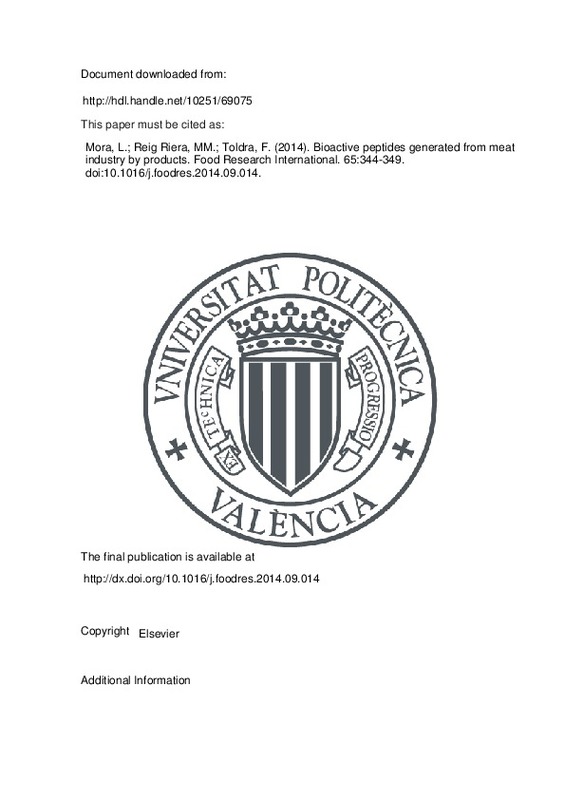

Listar por palabra clave "Bioactive peptides"
RiuNet: Repositorio Institucional de la Universidad Politécnica de Valencia
- RiuNet repositorio UPV
- :
- Listar por palabra clave
JavaScript is disabled for your browser. Some features of this site may not work without it.
Buscar en RiuNet
Listar
Mi cuenta
Ayuda RiuNet
Admin. UPV
Listar por palabra clave "Bioactive peptides"
Mostrando ítems 1-13 de 13
-
Mora, Leticia; Reig Riera, Mª Milagro; Toldra, Fidel (Elsevier, 2014-11)There is a large generation of meat by-products, not only from slaughtering but also in the meat industry from trimming and deboning during further processing. This results in extraordinary volumes of by-products that are ...
-
Toldrá Vilardell, Fidel; Gallego-Ibáñez, Marta; Reig Riera, Mª Milagro; Aristoy, M-Concepción; Mora, Leticia (Elsevier, 2020-08-15)[EN] Peptides and free amino acids are naturally generated in dry-cured ham as a consequence of proteolysis phenomenon exerted by muscle peptidases. The generation of bioactive peptides in different types of dry-cured ham ...
-
Mora Soler, Leticia; Gallego-Ibáñez, Marta; Reig Riera, Mª Milagro; Toldrá Vilardell, Fidel (Elsevier, 2017)[EN] Background: The final characteristics of processed meats depend on many factors but one of the most important is the intense proteolysis occurred in muscle proteins due to the action of endogenous enzymes in dry-cured ...
-
Sánchez Chica, Eylen Manuela (Universitat Politècnica de València, 2017-09-21)[ES] El desarrollo y aplicación de metodologías alternativas a la experimentación empírica tradicional resulta muy interesante para un mejor aprovechamiento de los recursos científicos y el tiempo de ensayo. La metodología ...
-
Moreno Mariscal, Cristina (Universitat Politècnica de València, 2022-10-20)[ES] Los iones inorgánicos están presentes en todos los alimentos de manera natural, pero, además, algunos se adicionan para ayudar en los procesos de fabricación de algunos alimentos, o, para mejorar sus características ...
-
Gallego Ibáñez, Marta; Mora Soler, Leticia; Hayes, María; Reig Riera, Mª Milagro; Toldrá Vilardell, Fidel (2017)[EN] Dry-cured ham by-products have been traditionally used in Mediterranean household cooking of broths and stews. The aim of this work was to evaluate the effect of cooking treatments and in vitro gastrointestinal digestion ...
-
Toldrá Vilardell, Fidel; Reig Riera, Mª Milagro; Aristoy Albert, María Concepción; Mora Soler, Leticia (Elsevier, 2018)[EN] Large amounts of peptides are naturally generated in foods through the proteolysis phenomena taking place during processing. Such proteolysis is carried out either by endogenous enzymes in ripened foods or by the ...
-
Toldrá Vilardell, Fidel; Reig Riera, Mª Milagro (Elsevier, 2011-09)[EN] Meat and meat products are generally recognised as good sources of high biological-value proteins, group B vitamins, minerals and trace elements as well as some other bioactive compounds. However, the image to consumers ...
-
Toldrá Vilardell, Fidel; Aristoy, M.-Concepción; Mora, Leticia; Reig Riera, Mª Milagro (Elsevier, 2012-11)[EN] While muscle foods are the more commonly consumed portion of an animal, meat by-products such as the entrails and internal organs are also widely consumed. Considered high-priced delicacies or waste material to be ...
-
Toldrá Vilardell, Fidel; Mora Soler, Leticia; Reig Riera, Mª Milagro (Elsevier, 2016)[EN] Meat industry generates large volumes of by-products like blood, bones, meat trimmings, skin, fatty tissues, horns, hoofs, feet, skull and viscera among others that are costly to be treated and disposed ecologically. ...
-
Rubio Vidal, Blanca (Universitat Politècnica de València, 2022-10-21)[ES] La industria cárnica genera muchos subproductos caros de gestionar y de alto impacto sobre el medio ambiente que se destinan a usos de bajo valor económico. Sin embargo, existe un gran interés por revalorizar dichos ...
-
Gallego-Ibáñez, Marta; Mora Soler, Leticia; Hayes, María; Reig Riera, Mª Milagro; Toldrá Vilardell, Fidel (American Chemical Society, 2019-01-30)[EN] The interest in using food byproducts as a source of bioactive peptides has increased significantly in the recent years. The goal of this work was to determine the presence and stability of peptides showing angiotensin ...
-
Toldrá Vilardell, Fidel; Gallego-Ibáñez, Marta; Reig Riera, Mª Milagro; ARISTOY ALBERT, MARÍA CONCEPCIÓN; Mora Soler, Leticia (American Chemical Society, 2020-11-18)[EN] There is a wide variety of peptides released from food proteins that are able to exert a relevant benefit for human health, such as angiotensin-converting enzyme inhibition, antioxidant, anti-inflammatory, hypoglucemic, ...
Mostrando ítems 1-13 de 13

Universitat Politècnica de València. Unidad de Documentación Científica de la Biblioteca (+34) 96 387 70 85 · RiuNet@bib.upv.es













